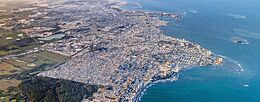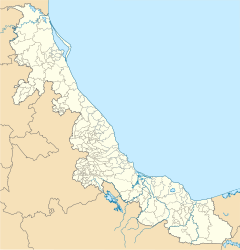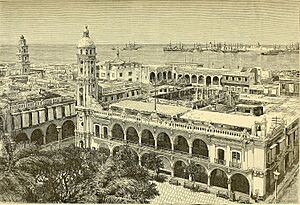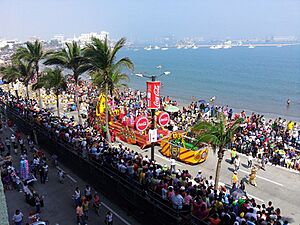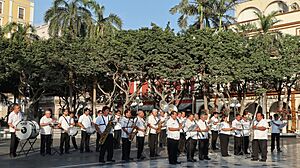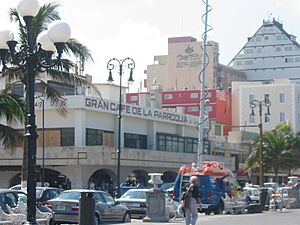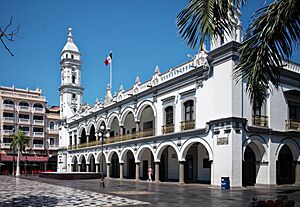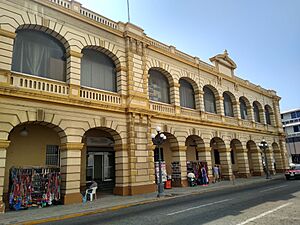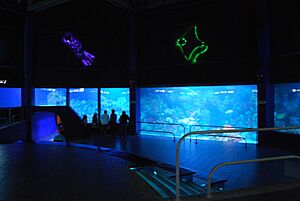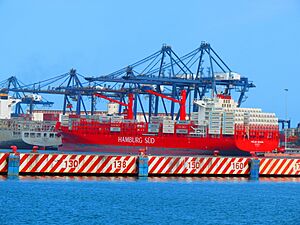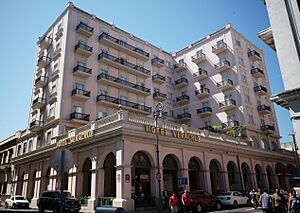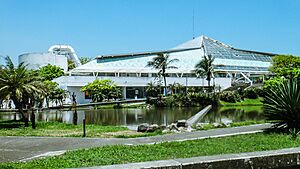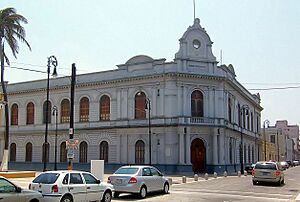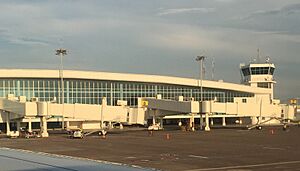Veracruz (city) facts for kids
Quick facts for kids
Veracruz
|
||
|---|---|---|
|
City and municipality
|
||
| Heroica Veracruz | ||
|
Top: Clavijero Theatre (left) and City Hall (right); middle top: aerial view of Veracruz; middle bottom: Portal de Miranda (left), Venustiano Carranza Lighthouse (center) and Veracruz Cathedral (right) ; bottom: Castle of San Juan de Ulúa (left) and Portales de Lerdo (right)
|
||
|
||
| Country | ||
| State | Veracruz | |
| Municipality | Veracruz | |
| Established | 22 April 1519 (506 years ago) |
|
| Founded as | Villa Rica de la Vera Cruz | |
| Founded by | Hernán Cortés | |
| Area | ||
| • Metro | 1,641.6 km2 (633.8 sq mi) | |
| Elevation | 10 m (30 ft) | |
| Population
(2020)
|
||
| • City and municipality | 537,963 | |
| • Metro | 968,070 (metro) | |
| GDP (PPP, constant 2015 values) | ||
| • Year | 2023 | |
| • Total | $19.1 billion | |
| • Per capita | $20,000 | |
| Time zone | UTC−6 (CST) | |
| • Summer (DST) | UTC−5 (CDT) | |
| Website | veracruzmunicipio.gob.mx | |
Veracruz (pronounced beɾaˈkɾus), also known as Heroica Veracruz, is a big port city in Mexico. It's located on the Gulf of Mexico coast in the state of Veracruz. The city is about 90 kilometers (56 miles) southeast of Xalapa, the state capital.
Veracruz is the most populated city in its state. Part of the city even extends into the nearby municipality of Boca del Río. In 2020, the Veracruz Municipality had over 607,000 people. The city itself had about 537,000 residents.
This city is very important to Mexico's history. It was the first Spanish settlement on the mainland of the Americas. It was founded by the Spanish explorer Hernán Cortés on April 22, 1519. He named it Villa Rica de la Vera Cruz. This name means "Rich Village of the True Cross". He chose it because he found gold there and landed on Good Friday, a Christian holy day.
Veracruz became Mexico's oldest and largest port. During the time of Spanish rule, it was a very wealthy trading center. Its riches attracted pirates in the 1600s, leading to the building of forts like Fort San Juan de Ulúa. Later, in the 1800s and early 1900s, France and the United States invaded Veracruz several times.
Today, Veracruz is still a main port for Mexico's imports and exports, especially for cars. The city has a mix of cultures, including Native Mexican, Spanish, and Afro-Caribbean influences. You can see this blend in the local food and music.
Contents
What's in a Name?
The name Veracruz comes from the Latin words Vera Crux, which mean "True Cross". When Hernán Cortés started the settlement on Good Friday, April 22, 1519, he named it Villa Rica de la Vera Cruz. This was an offering to the True Cross because of the holy day.
A Look Back in Time
Spanish Rule (1518-1821)
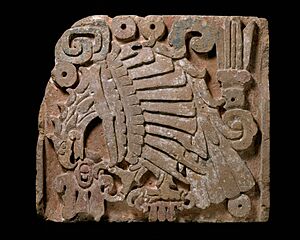
The Spanish captain Juan de Grijalva first arrived in this area in 1518. He landed on an island now known as San Juan de Ulúa. He named it after John the Baptist because he arrived on his feast day. The name "Ulúa" comes from a local word for the Aztecs.
Hernán Cortés founded Veracruz in 1519. At that time, the area was part of the Aztec Empire ruled by Moctezuma II. Cortés and his men landed on the shore opposite the island. They named their new settlement Villa Rica de la Vera Cruz. "Villa Rica" meant "rich village" because of the gold they found. "Vera Cruz" meant "True Cross" because they landed on Good Friday.
Cortés and his soldiers set up the first city council in the Americas. This city was also the first on the American mainland to get a European coat of arms. This special honor was given by Carlos V of Spain in 1523.
The original settlement was moved in 1525 to a place called Antigua. This move separated the city from the port, as ships couldn't easily enter the shallow river. Ships continued to use San Juan de Ulúa for docking.
Like other parts of Mexico, the indigenous peoples here suffered greatly from European diseases. Many people died. The Portuguese Empire also started bringing African slaves through the port of Veracruz. In the 1500s, this state had more slaves than any other in Mexico.
Veracruz became the most important port in New Spain (colonial Mexico). It had many wealthy merchants. Twice a year, Spanish treasure fleets would gather here. They would load up with goods, gold, and silver to send back to Spain.

This wealth attracted pirates. In 1568, the Spanish navy fought off British pirates John Hawkins and Francis Drake. To protect the city, the Spanish built Fort San Juan de Ulúa in the mid-1500s. In 1600, the city was moved back to its original spot to stop smuggling. Docks and a watchtower were built to control trade.
Important public buildings were built in the early 1600s. These included the city hall and hospitals. In 1618, a big fire almost destroyed the city. In 1683, pirates led by Nicholas van Hoorn, Laurens de Graaf, and Michel de Grammont attacked Veracruz.
In the 1700s, Veracruz's defenses were made even stronger. A wall was built around the city in 1790, along with forts and gates. San Juan de Ulúa was also improved. This was to protect the valuable port from invasions, like the British attack on Havana. Many of Veracruz's historic buildings, like the cathedral (1731) and the Military Hospital of San Carlos (1731), are from this time.
In 1804, the Balmis Expedition brought the smallpox vaccine to Veracruz. From here, it was sent all over New Spain. The 1800s were a time of many wars. During the Mexican War of Independence, Spain kept troops here to control the sea route to Mexico City. In 1820, Mexican rebels took the city. The last Spanish ruler of New Spain, Juan O'Donojú, signed the Treaty of Córdoba here in 1821. This treaty officially ended Spanish rule. In 1823, Spanish troops still at Fort San Juan de Ulúa fired on the newly independent city. Finally, in 1825, the last Spanish troops left San Juan de Ulúa.
Mexico's Independence (since 1821)
Veracruz earned its first title of "Heroic City" for defending itself against attacks. During the Pastry War in 1837, the city bravely defended itself against a French attack. This earned it a second "Heroic City" title.
In 1847, during the Mexican–American War, United States forces invaded the city. Generals Juan Morales and José Juan de Landero defended it. After a long fight, Veracruz and San Juan de Ulúa were taken by the US army on March 29.
Ten years later, a civil war in Mexico forced President Benito Juárez to leave Mexico City. He governed from Veracruz in 1857. In 1861, Spain sent troops to occupy the port to collect debts. French forces joined them and occupied the city when Emperor Maximiliano I arrived in 1864.
The 1900s
The many conflicts and damaged trade hurt Veracruz's port. By 1902, the port was in bad shape. President Porfirio Díaz hired foreign companies to modernize it.

Between April and November 1914, during the Mexican Revolution, the US attacked and occupied the port. This was to try and protect trade. The city earned its fourth title of "Heroic City" for its defense.
After the Revolution, most port workers joined unions. These unions gained a lot of power over how the port operated. By the late 1900s, different unions made it hard to run the port smoothly. There were also problems with corruption.
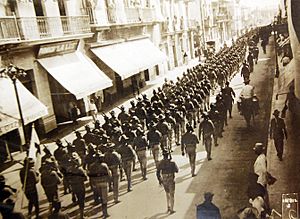
In the 1970s, the government created a plan to improve Mexico's ports. New laws allowed the government to take control of important ports like Veracruz. The port was modernized with new technology for loading and unloading. This meant fewer jobs, but the unions worked together. They negotiated for workers to be part of a new company that would manage the port. The new system was fully in place by 1991.
The 2000s
In September 2010, Hurricane Karl, a strong hurricane, caused huge floods and damage. About half a million people were affected. Sixteen people died, and eleven went missing. Sixty-five areas in the state were declared disaster zones. The damage was estimated to be billions of dollars.
Veracruz's Location and Nature
The city of Veracruz is the main center for 128 other smaller towns. Together, they form a municipality that covers 241 square kilometers (93 sq mi). Most of the municipality's 552,156 people live in the city itself. The area is mostly flat and is crossed by the Medio, Grande, and Tonayán Rivers. It has an average height of 10 meters (33 feet) above sea level.
Veracruz has a tropical climate. The average temperature is 25.3°C (77.5°F). The area has many rainforest-like plants. Many trees lose their leaves in the dry winter. You can find birds, small mammals, and insects here.

Much of the land outside the city is used for farming and raising animals. Farmers grow corn, beans, watermelon, oranges, and sugarcane. They also raise cattle, pigs, and horses. There are also some forests. The ground in the municipality has marble, lime, cement, sand, and clay. Around the city, there are factories that make paints, food products, plastics, and metals.
Veracruz has many beaches and islands off its coast. One island is Isla de Sacrificios, which is 450 meters (1,476 feet) long and 198 meters (650 feet) wide. This island is part of the Veracruz Reef System, a national park with twenty-three coral reefs. Visitors can kayak to the island to see seagulls, pelicans, and fish. The island was closed to the public in 1983 for cleanup and has mostly been used for research since then.
Other small islands and sandbars off the coast include Isla de Enmedio, Isla Verde, and Santiaguillo. All of these are part of the Veracruz Reef System national park. They are great places for SCUBA diving. Many companies in Veracruz offer diving equipment and tours. The best time for diving is from May to August.
The mainland also has several beaches. Playa Martí is between Veracruz city and Boca del Río. Playa de Hornos is next to the Veracruz Aquarium. You can also take boats to Isla Canuncito. Villa del Mar is just south of Playa de Hornos.
Veracruz's Weather
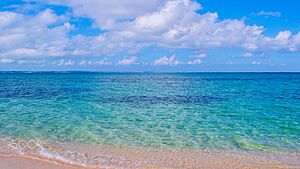
Veracruz has a tropical savanna climate. This means it has a wet season and a dry season. The wet season is usually from June to October. Most of the year's rain falls then. Big tropical thunderstorms happen almost every day in the late afternoon. The wet season is hotter and more humid.
The dry season is from November to May. Temperatures are a bit cooler and the air is less humid. This makes it a popular time for tourists to visit. Even in the dry season, winters can be foggy and cloudy. Many tourists come to Veracruz during Christmas and spring break because of the pleasant weather.
Veracruz gets about 1,564 millimeters (61.6 inches) of rain each year. July is the wettest month, with about 385 millimeters (15.2 inches) of rain. March is the driest, with only 13 millimeters (0.5 inches). The hottest months are June and August, with average temperatures of 28°C (82°F). January is the coolest month, with an average of 21.2°C (70.2°F).
| Climate data for Veracruz (Synoptic Observatory), elevation: 19.4 m, 1981-2000 averages, extremes 1951-2000 | |||||||||||||
|---|---|---|---|---|---|---|---|---|---|---|---|---|---|
| Month | Jan | Feb | Mar | Apr | May | Jun | Jul | Aug | Sep | Oct | Nov | Dec | Year |
| Record high °C (°F) | 34.7 (94.5) |
33.2 (91.8) |
39.2 (102.6) |
39.5 (103.1) |
39.5 (103.1) |
36.7 (98.1) |
37.0 (98.6) |
36.0 (96.8) |
35.4 (95.7) |
35.0 (95.0) |
34.0 (93.2) |
36.0 (96.8) |
39.5 (103.1) |
| Mean daily maximum °C (°F) | 24.7 (76.5) |
25.0 (77.0) |
27.4 (81.3) |
29.2 (84.6) |
31.1 (88.0) |
31.4 (88.5) |
31.2 (88.2) |
31.2 (88.2) |
30.8 (87.4) |
29.7 (85.5) |
27.7 (81.9) |
25.9 (78.6) |
28.8 (83.8) |
| Daily mean °C (°F) | 21.5 (70.7) |
21.9 (71.4) |
24.0 (75.2) |
25.8 (78.4) |
27.8 (82.0) |
28.1 (82.6) |
27.5 (81.5) |
27.6 (81.7) |
27.2 (81.0) |
26.2 (79.2) |
24.2 (75.6) |
22.6 (72.7) |
25.4 (77.7) |
| Mean daily minimum °C (°F) | 18.4 (65.1) |
18.8 (65.8) |
20.7 (69.3) |
22.5 (72.5) |
24.6 (76.3) |
24.8 (76.6) |
23.8 (74.8) |
23.9 (75.0) |
23.6 (74.5) |
22.7 (72.9) |
20.7 (69.3) |
19.3 (66.7) |
22.0 (71.6) |
| Record low °C (°F) | 5.8 (42.4) |
7.2 (45.0) |
2.0 (35.6) |
9.0 (48.2) |
14.5 (58.1) |
17.0 (62.6) |
19.8 (67.6) |
13.2 (55.8) |
17.0 (62.6) |
12.0 (53.6) |
2.0 (35.6) |
0.2 (32.4) |
0.2 (32.4) |
| Average precipitation mm (inches) | 37.9 (1.49) |
17.8 (0.70) |
13.1 (0.52) |
24.4 (0.96) |
74.2 (2.92) |
196.3 (7.73) |
385.1 (15.16) |
320.5 (12.62) |
292.6 (11.52) |
130.7 (5.15) |
32.0 (1.26) |
39.6 (1.56) |
1,564 (61.57) |
| Average precipitation days (≥ 0.1 mm) | 5.3 | 3.1 | 3.8 | 3.8 | 5.0 | 12.8 | 18.5 | 16.4 | 15.4 | 10.6 | 6.2 | 5.7 | 106.7 |
| Average relative humidity (%) | 81.0 | 79.0 | 74.0 | 77.0 | 72.0 | 73.0 | 79.0 | 80.0 | 79.0 | 77.0 | 79.0 | 81.0 | 77.6 |
| Mean monthly sunshine hours | 162.0 | 165.0 | 192.0 | 205.0 | 203.0 | 207.0 | 187.0 | 177.0 | 162.0 | 170.0 | 179.0 | 161.0 | 2,170 |
| Source: SMN | |||||||||||||
| Climate data for Veracruz (Synoptic Observatory), elevation: 19.4 m, 1961-1990 normals | |||||||||||||
|---|---|---|---|---|---|---|---|---|---|---|---|---|---|
| Month | Jan | Feb | Mar | Apr | May | Jun | Jul | Aug | Sep | Oct | Nov | Dec | Year |
| Mean daily maximum °C (°F) | 24.3 (75.7) |
24.6 (76.3) |
26.5 (79.7) |
28.7 (83.7) |
30.4 (86.7) |
30.8 (87.4) |
30.9 (87.6) |
31.2 (88.2) |
30.8 (87.4) |
29.6 (85.3) |
27.6 (81.7) |
25.5 (77.9) |
28.4 (83.1) |
| Daily mean °C (°F) | 21.2 (70.2) |
21.6 (70.9) |
23.4 (74.1) |
25.6 (78.1) |
27.4 (81.3) |
28.0 (82.4) |
27.6 (81.7) |
28.0 (82.4) |
27.6 (81.7) |
26.5 (79.7) |
24.5 (76.1) |
22.5 (72.5) |
25.3 (77.5) |
| Mean daily minimum °C (°F) | 18.1 (64.6) |
18.5 (65.3) |
20.6 (69.1) |
22.8 (73.0) |
24.6 (76.3) |
24.5 (76.1) |
23.6 (74.5) |
23.9 (75.0) |
23.6 (74.5) |
22.7 (72.9) |
20.9 (69.6) |
19.3 (66.7) |
21.9 (71.4) |
| Average precipitation mm (inches) | 22.0 (0.87) |
17.0 (0.67) |
17.0 (0.67) |
22.0 (0.87) |
46.0 (1.81) |
302.0 (11.89) |
411.0 (16.18) |
352.0 (13.86) |
352.0 (13.86) |
131.0 (5.16) |
54.0 (2.13) |
27.0 (1.06) |
1,753 (69.03) |
| Average precipitation days (≥ 0.1 mm) | 4.0 | 4.0 | 4.0 | 4.0 | 5.0 | 14.0 | 21.0 | 19.0 | 18.0 | 12.0 | 8.0 | 6.0 | 119 |
| Average relative humidity (%) | 75.5 | 76.0 | 74.0 | 75.0 | 75.5 | 78.0 | 77.0 | 77.0 | 74.5 | 73.0 | 73.5 | 76.0 | 75.4 |
| Mean monthly sunshine hours | 146.3 | 157.9 | 188.9 | 205.9 | 205.4 | 208.0 | 205.1 | 222.5 | 188.7 | 193.5 | 178.7 | 145.8 | 2,246.7 |
| Source: NOAA | |||||||||||||
| Climate data for Veracruz (Synoptic Observatory), elevation: 19.4 m, 1951-1980 normals and extremes | |||||||||||||
|---|---|---|---|---|---|---|---|---|---|---|---|---|---|
| Month | Jan | Feb | Mar | Apr | May | Jun | Jul | Aug | Sep | Oct | Nov | Dec | Year |
| Record high °C (°F) | 32.7 (90.9) |
33.2 (91.8) |
37.7 (99.9) |
39.5 (103.1) |
36.8 (98.2) |
36.3 (97.3) |
36.0 (96.8) |
35.3 (95.5) |
35.0 (95.0) |
34.4 (93.9) |
32.6 (90.7) |
36.0 (96.8) |
39.5 (103.1) |
| Mean daily maximum °C (°F) | 24.6 (76.3) |
24.9 (76.8) |
26.5 (79.7) |
28.6 (83.5) |
30.2 (86.4) |
30.7 (87.3) |
30.7 (87.3) |
31.2 (88.2) |
30.7 (87.3) |
29.6 (85.3) |
27.4 (81.3) |
25.4 (77.7) |
28.4 (83.1) |
| Daily mean °C (°F) | 21.4 (70.5) |
21.8 (71.2) |
23.5 (74.3) |
25.7 (78.3) |
27.4 (81.3) |
27.9 (82.2) |
27.6 (81.7) |
28.0 (82.4) |
27.6 (81.7) |
26.4 (79.5) |
24.2 (75.6) |
22.2 (72.0) |
25.3 (77.6) |
| Mean daily minimum °C (°F) | 21.4 (70.5) |
21.8 (71.2) |
23.5 (74.3) |
25.7 (78.3) |
27.4 (81.3) |
27.9 (82.2) |
27.6 (81.7) |
28.0 (82.4) |
27.6 (81.7) |
26.4 (79.5) |
24.2 (75.6) |
22.2 (72.0) |
25.3 (77.6) |
| Record low °C (°F) | 10.5 (50.9) |
8.7 (47.7) |
12.7 (54.9) |
15.8 (60.4) |
17.7 (63.9) |
17.0 (62.6) |
20.4 (68.7) |
20.5 (68.9) |
17.0 (62.6) |
16.8 (62.2) |
13.1 (55.6) |
9.0 (48.2) |
8.7 (47.7) |
| Average precipitation mm (inches) | 24.1 (0.95) |
16.0 (0.63) |
14.5 (0.57) |
17.4 (0.69) |
48.2 (1.90) |
298.3 (11.74) |
419.9 (16.53) |
323.1 (12.72) |
358.6 (14.12) |
152.9 (6.02) |
59.6 (2.35) |
24.4 (0.96) |
1,757 (69.18) |
| Average precipitation days (≥ 0.1 mm) | 4.83 | 3.51 | 3.17 | 3.31 | 4.93 | 14.82 | 20.63 | 18.6 | 17.7 | 11.36 | 7.4 | 5.8 | 116.06 |
| Average relative humidity (%) | 80.0 | 80.0 | 81.0 | 80.0 | 78.0 | 79.0 | 79.0 | 78.0 | 78.0 | 74.0 | 77.0 | 80.0 | 79.0 |
| Mean monthly sunshine hours | 147.3 | 166.2 | 175.7 | 182.1 | 194.7 | 203.2 | 200.0 | 227.0 | 174.5 | 193.0 | 165.5 | 140.7 | 2,169.9 |
| Source: COLPOS | |||||||||||||
Veracruz Culture
Veracruz has always been a place where different cultures mix. This is because it's a major port city. The main influences are Spanish, Native Mexican, and African. During colonial times, African slaves were brought here to work. After Mexico became independent, people from Italy and Cuba also settled in the city.
The Veracruz Carnaval is a huge celebration. It has been held every year since 1866. It started as a "Festival of Masks" with dances. Now, it's a big street party with a famous parade. The Carnaval begins with the "Burning of Bad Humor" and ends with the "Burial of Juan Carnaval." It's the biggest Carnaval celebration in Mexico!
Sugar and rum production have always been important here. These industries brought many workers, including immigrants. All these groups have created a rich culture. The Naval Academy also brings people from Mexico and other countries, adding to the city's diverse mix.
Veracruz is known for being a lively city. Many people enjoy being out in the squares, listening to music late into the night. In the mornings, they go to sidewalk cafes for coffee. Veracruz is also a popular place for filming movies.
Veracruz Music
The famous song "La Bamba" comes from Veracruz. It's part of a music style called "son". This music has African and Caribbean influences. It's popular all over Mexico, Latin America, and the United States.
Traditional Veracruz music is called "Son Jarocho". While there are many types of "son" music in Mexico, Son Jarocho is most linked to Veracruz. Another type is "Son Comercial." This style is faster and often seen in Mexican folkdance shows. Dancers wear long white dresses and dance with partners also dressed in white. Son Comercial developed in the 1940s from Son Jarocho.
You can often hear "son" singers in the main plaza (Zócalo). The Casa de Cultura also offers workshops for traditional music.
Veracruz Food
Veracruz recipes use corn, beans, and squash as main foods. This tradition comes from the ancient indigenous peoples. Local diets also include tropical foods like chili peppers, tomatoes, avocados, pineapples, and papaya. These have been grown here since before Europeans arrived.
The Spanish brought new ingredients like parsley, thyme, marjoram, bay laurel, and coriander. They also brought saffron, wheat, rice, almonds, olives, garlic, and capers. Because Veracruz was a major port for so long, these ingredients are used more here than in other parts of Mexico.
A famous local dish is Huachinango a la Veracruzana. This is red snapper cooked Veracruz-style. It uses local fruits and vegetables like tomatoes and chili peppers. It also includes Spanish ingredients like olive oil, garlic, and capers. Other popular dishes are arroz a la tumbada, a rice dish with seafood, and caldo de mariscos, a seafood soup.
Coffeehouses are important social places in Veracruz. The Gran Café del Portal and the Café de la Parroquia are the most famous. To ask for a coffee refill, customers clink their glasses with their spoons. You can hear this sound all day long. This tradition started because a trolley driver used to ring his bell to let waiters know he was coming. After he died, people started tapping their glasses in his honor.
Famous Places in Veracruz

Veracruz is becoming a popular tourist spot. It has new attractions like the Veracruz Aquarium and the City Museum. It also has historic places like Fort San Juan de Ulúa and the Naval Academy.
The main cultural center of the city is its main plaza, called the Zócalo. This square is full of life from morning to night. People play dominos, sell food, listen to music, and dance. In the evenings, you can often see people dancing the danzón. This dance came from Cuba in the 1870s. Around the plaza, you'll find many shops, restaurants, the city hall, and the cathedral.
The Municipal Palace (city hall) was built in 1608. It was rebuilt in the 1700s. It has a simple Baroque style with a tower. Lookouts used the tower to watch ships. It has a large courtyard with wide arches. This is the oldest city government building in Mexico.
The Cathedral of Veracruz, called Catedral de la Virgen de la Asunción, is also on the Zócalo. It was started in the 1600s and finished in 1731. It was changed in the 1800s and became a cathedral in 1963. The building has five sections and a dome covered in colorful Puebla tiles.

In the port area, you can see the Pemex Tower and the old lighthouse. This lighthouse was once the government seat for Venustiano Carranza. There's also a Crafts Market. On Marina Mercante Street, you'll find the Old Customs Building, the Postal and Telegraph buildings, and the old train station.
The malecón (boardwalk) stretches for kilometers along the Gulf of Mexico. It's a popular place at night for people to walk and enjoy the ocean breeze. Near the city center, the malecón is full of vendors selling souvenirs and jewelry.
Fort San Juan de Ulúa is on an island connected to the mainland. This island is part of a coral reef and has beaches. In ancient times, this island was a special place for the god Tezcatlipoca. The fort was built where the Spanish first landed in 1519. It was used to defend the city from pirates and later as a prison. The fort was started in 1582 and finished in 1707.
After Mexico's independence in 1821, the Spanish kept control of the fort for a few years. They sometimes fired cannons at the city. Mexico finally took control in 1825. The fort was used in wars with France (1838) and the United States (1847).
In the 1800s, the fort became a military prison. Its thick stone walls and narrow passages led to dark dungeons. Some of the most feared cells were nicknamed "Heaven," "Purgatory," and "Hell." Famous prisoners included Fray Servando Teresa de Mier and Benito Juárez. The most famous prisoner was Jesús Arriaga, known as "Chucho el Roto."
Chucho el Roto was a bit like Robin Hood. He stole from the rich to help the poor. He was arrested and sent to Fort San Juan de Ulúa, where he died. No one is sure how he died. His story inspired many songs and poems.
Along with the fort, Veracruz used to have city walls to protect it. All that's left of these walls is the Baluarte, a small fortress. This 1635 structure has strong walls and cannons. Inside, there's a small museum with ancient jewelry found by a fisherman in the 1970s.
The Veracruz Aquarium was built in 1992. It's the biggest and most important aquarium in Latin America. It has freshwater exhibits with species from Asia, Africa, South America, and Mexico. The Reef Tank is famous for its sharks. There's a glass tunnel where you can walk through a shark tank. There's also a special exhibit for manatees.
The Heroic Naval School (Heroica Escuela Naval) was founded here in 1897. It trains officers for the Mexican Navy and Merchant Marine.
The City Museum (Museo de la Ciudad) is in a two-story building in the historic center. It was built in the mid-1800s in a neoclassic style. The building was first an asylum. When the French invaded Veracruz in 1861, it was used for other purposes. The asylum returned until 1970, when the building became a museum. It shows exhibits about Veracruz's history.

The Agustín Lara House Museum shows works, photos, and personal items of the poet Agustín Lara. It's in his old house in Boca del Río, near Veracruz. Lara was a famous songwriter and singer from the city. He wrote the song "María Bonita" for his wife, María Félix.
Veracruz Economy
The Laguna Verde Nuclear Power Plant (LVNPP) is nearby. It produces about 4.5% of Mexico's electricity.
The Port of Veracruz
The Port of Veracruz is Mexico's oldest and largest port. It has played a huge role in the country's history. During colonial times, it was the most important port in New Spain. It connected Mexico to Europe and the Atlantic trade. This made the merchants in Veracruz very rich.
From Veracruz, Mexico exported turkeys, corn, beans, avocados, and cotton to Spain. From Spain, Mexico received fava beans, wheat, rice, cattle, and fabric. In the mid-1500s, so much gold and silver was found that these precious metals became the main export to Spain. These "treasure ships" attracted pirates like Francis Drake and John Hawkins. Veracruz was also invaded during conflicts with France and the United States.
In the late 1800s, Veracruz's importance decreased as trade with Europe slowed. The port was updated in the early 1900s. However, oil production became more important for the state than the port. This changed in the late 1900s, and the port became important again.
In 1991, the federal government took over the port to improve how goods were handled. Soon after, private shipping companies started working there. In 1993, a new law created the Port Authority of Veracruz.
Today, the port handles all kinds of cargo. In 2004, it moved 16.1 million tons of products. This number is expected to grow. Veracruz is a key entry point for Mexico's car industry. This port is the first to be specially equipped for shipping cars. It's close to car factories and has good access to markets in the U.S., Europe, and Central and South America. In 2004, the port handled 70% of Mexico's car exports. The port handles between 700,000 and 800,000 vehicles each year, which is the largest amount on the continent.
Learning in Veracruz
The Universidad Veracruzana was started in 1944. It brought together several schools and colleges. Now, it's the main center for higher education in Veracruz state. It has five main campuses and many smaller locations. About 70,000 students attend, studying in sixty different fields.
There are also private universities. Cristóbal Colón University focuses on architecture and business. UNIMEX was founded in 1991 and teaches marketing, graphic design, and law.
The Veracruz Institute of Technology was founded in 1946. It started as a school to train students for jobs in the growing port and industries. It began by teaching high school students and later added bachelor's degree programs. In the 1960s, technical programs became the main focus. The Veracruz Institute of Technology is known for its biochemical engineering programs.
The Illustrious Veracruzan Institute was founded in 1853.
Getting Around Veracruz
The General Heriberto Jara International Airport serves Veracruz. It has daily flights to Mexico City and international flights to Houston. Airlines like Aeromexico, United Airlines, and Viva Aerobus use this airport. In 2021, over 1.1 million passengers used the airport.
Trains (run by Kansas City Southern de México) connect Veracruz with Mexico City and Xalapa.
Veracruz is linked to Mexico City by a four-lane highway that also goes through Córdoba and Puebla. Another highway connects to Xalapa.
The city used to have a tram system from 1908 to 1981. Now, the city has buses. There are also trolley-replica tour buses that look like old trams and are popular in the evening.
Veracruz Sister Cities
Veracruz is connected with these cities around the world:
 Cádiz, Spain
Cádiz, Spain Callao, Peru
Callao, Peru Galveston, United States
Galveston, United States Havana, Cuba
Havana, Cuba Laredo, United States
Laredo, United States Miami-Dade County, United States
Miami-Dade County, United States Mobile, United States
Mobile, United States Ordes, Spain
Ordes, Spain Oviedo, Spain
Oviedo, Spain Pharr, United States
Pharr, United States Quetzaltenango, Guatemala
Quetzaltenango, Guatemala San Jose, United States
San Jose, United States Santos, Brazil
Santos, Brazil Seville, Spain
Seville, Spain Tampa, United States
Tampa, United States Valencia, Spain
Valencia, Spain Valparaíso, Chile
Valparaíso, Chile
|
See also
 In Spanish: Veracruz para niños
In Spanish: Veracruz para niños




